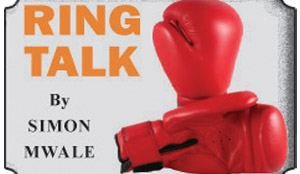 IN November, 2013, referee Howard Foster had to be hidden under a coat and smuggled from ringside by security men after he had controversially stopped a WBA middleweight title fight between George Groves and champion Carl Froch in England.
IN November, 2013, referee Howard Foster had to be hidden under a coat and smuggled from ringside by security men after he had controversially stopped a WBA middleweight title fight between George Groves and champion Carl Froch in England.
Froch, who secured back-to back wins against Groves believes that the career of Groves was saved by the eighth round stoppage of their first fight, with Groves close to tears of frustration as he claimed he was the victim of “an injustice” when Foster stepped in quickly to halt the fight, incensing the crowd in Manchester.
This past week, at Arthur Davies Stadium in Kitwe, Bazila Ngosa dramatically and violently protested referee Maybin Kante’s third round stoppage of the fight against Kenya’s Francis Kimani after as many knock downs against Ngosa from vicious blows to the head.
This was for the World Professional Boxing Federation African super featherweight crown which Kimani won. In this piece, I deal with the question: when is it OK for a referee to stop a bout?
Did referee Kante stop the fight prematurely as claimed by Ngosa and his promoter Mwenya Musenge? To shed light on this topical matter, I will lean on an excerpt from “The Professional Boxing Referee Manual.”
Armando Garcia who writes for the manual correctly notes that when to stop or not stop a bout are the most difficult and critical decisions a referee has to make in the ring.
If done too fast, the event is ruined completely. If done too slow, the boxer could become seriously injured or die. Only good judgment and ring experience can help a referee make these decisions correctly.
The general rules of boxing as well as all organised rules dictate that a boxer is deemed downed if when struck by a legal blow(s) any part other than the soles of his feet touch the canvas.
He may also be considered down if he is hanging helplessly on the ropes as a result of a legal blow(s); (Grove’s case) or, if when struck by a legal blow(s) only the ropes prevented him from being knocked down.
Sometimes, one sees boxers badly hurt from taking repeated punches on the ropes or being struck hard with punches and bouncing off the ropes and knockdowns are not called. Referees tend to call only clear and obvious knockdowns.
This was the case in Ngosa’s case. The two fighters were exchanging vicious punches in the centre of the ring when Ngosa was caught with one heavy fight- defining blow.
However, in cases when a boxer is struck hard and is held up by the ropes, and his reaction is poor, a knockdown call may be appropriate.
In these rare cases, the knockdown rule is not being consistently or aptly applied.
Granted, it takes great judgment, knowledge and guts to make these calls, but not making these calls at the appropriate times in the appropriate cases, however rare they are, is detrimental to a boxer’s health. This, I believe, was the spirit in which Kante made the decision to halt the proceedings.
The referee should pay close attention to all knockdowns. Some situations require closer attention. They are: (i) the boxer goes down hard and hits the back of his head on the canvas. Striking the canvas in this manner greatly increases the risk of injury.
(ii)the boxer goes down face first (Ngosa’s case). This clear unnatural reaction to being struck demonstrates a complete loss of muscle control. When a boxer goes down like this, most likely the bout is over. This explains why Kante waived off the fight.
(iii) when the boxer’s neck strikes the bottom or middle ropes as he is falling back and then it bounces up.
(iv) the boxer goes down and then, during your count, he goes down again without receiving another blow.
In all knockdown situations, if a boxer goes down there is a mandatory eight count. Kante gave Ngosa two mandatory eight counts for the first and second knockdowns and, after assessing his condition, allowed the fight to continue as the boxer rose to his feet during the counts. The sport demands a definitive conclusion to every bout. Considering this when making critical decisions is vital.
There are tell tale signs that help a referee make his critical decision or evaluating a downed boxer. They include: strong fatigue, change of skin color, open mouth with poor heavy breathing, unbalanced stance or gait, dazed look, bad cuts, lacerations or swellings and disorientation.
Fans love the knockout. Referees should fear it. One solid blow or combination of blows can leave you with a fallen boxer. Fallen for good. For comments: mwale.simon@yahoo.co.uk / 0966 755 574






